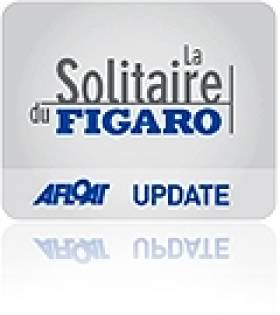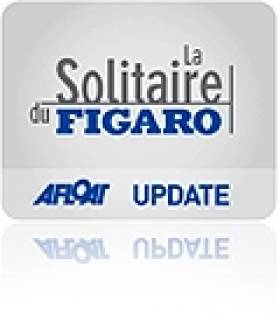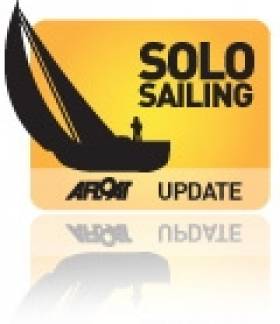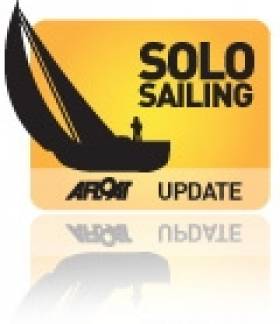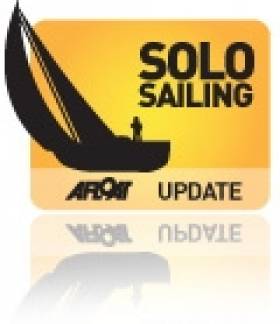Displaying items by tag: David Kenefick
Kenefick Sails into Roscoff with La Solitaire Figaro Fleet
#fullirish – Royal Cork's David Kenefick and The La Solitaire du Figaro fleet sailed in to Roscoff this morning at the end of two with the solo Irish sailor now 25th overall from 38 after the second stage of four in the intrepid race. Straight from his Full Irish nboat he has sent Afloat.ie readers the following report:
'That was a tough leg, but they always are. I shouldn't be frustrated, I'm hitting good places from time to time. I'm often playing well into the top half of the fleet and the top ten which was never the case last year. I'm going fast, faster than I ever have before and I',m always in the pack. This last leg was one that was rather unusual. There weren't many opportunities to do anything other than lose places. I had a good start and a really good second beat meaning I was in a good eighth place leaving Plymouth. My first big mistake was sailing too close to the Lizard off the South West Coast of England. We were really late starting and the tide was away by the time we got there and there was better pressure offshore. I lost a couple of miles there, miles that were never going to come back.
The Scillys were amazing with this great weather we are having. Dodging the various TSS zones kept us working hard and the long tight white sail reach out to the Stags was actually rather monotonous. It was difficult to stay awake on this leg and I had to sleep a lot. Just a few degrees up or down seemed to make quite a difference in the shifty dropping breeze.
It was great to see this small RIB approaching me at seven in the morning 10 miles off the Irish coast. I had a feeling that something like this would happen but when I saw Neil (dad) and George (brother) on board, well it was a special moment. I'd like to have been further up the fleet but they could see I was in the pack. Plenty of moral encouragement and banter...
Eventually when we got to the Stags off the Irish coast the fleet had bunched up again and pretty much all boats were in sight after two days. The run down the coast past Baltimore, Sherkin and Cape Clear was a great time, Dolphins and Whales and all my competitors raving about the wildlife and the good weather and the scenery on the VHF.
I was the first of the fleet to gybe offshore to try and get better breeze away from Cape Clear, and approaching the Fastnet with my Shamrock spinnaker set will be a photograph to keep.
The way back to Roscoff saw us tight reaching under headsails and at every corner we got lifted and were able to make it without tacking. It took a really long time and there were times I was fast and putting distance on people I've been training with over the winter and people who beat me big time last year.
We got into Roscoff just before dawn this morning and I finished 23rd, three and a half hours behind Yann Elies who is on fire with speed. He was leading the first leg when he dropped his mast at the Wolf Rock and then won this leg by almost an hour from the second boat. Impossible for him to win three in a row counting a retirement but a class act to sail with. I'm 25th overall after two legs and just five hours off the lead. After two legs it is still a very compact leaderboard and a huge amount can still happen over the next two legs. I'm gonna rest for the next few days, the next start is on Sunday 22nd June and it is looking like a windy downwind slide for the first two days. Looking forward to it, but not straight away. Thanks for you support.'
The skipper of Groupe Queguiner was first across the line in Roscoff at the end of Leg 2 of La Solitaire du Figaro-Eric Bompard. Elies finished at 01:26:01 after 3 days 3 hours 0 minutes and 01 second with an average speed of 7.3kn over the 535nm Leg. Corentin Horeau (Bretagne - Credit Mutuel Performance) finished second in the second Leg of La Solitaire du Figaro-Eric Bompard cachemire at 01:24:43 BST.
Jeremie Beyou (Maitre Coq) finished in 3rd, 40 seconds later at 01:25:47BST and Fabien Delahaye (Skipper Macif) crossed the line in 4th at 01:26:19BST
First ten finishers, stage 2:
1. Groupe Queguiner - Leucemie Espoir, Yann Elies
2. Bretagne Credit Mutuel Performance, Corentin Horeau
3. Maitre Coq, Jeremie Beyou
4. Skipper Macif 2012, Fabien Delahaye
5. Interface Concept, Gildas Mahe
6. Agir Recouvrement, Adrien Hardy
7. Groupe Fiva, Alexis Loison
8. Normandy Elite Team, Charlie Dalin
9. Cercle Vert, Gildas Morvan
10. Un Maillot Pour La Vie, Corentin Douguet
After 2 stages, overall top ten:
1. Skipper Macif 2012, Fabien Delahaye
2. Maitre Coq, Jeremie Beyou
3. Groupe Fiva, Alexis Loison
4. Bretagne Credit Mutuel Performance, Corentin Horeau
5. Normandy Elite Team, Charlie Dalin
6. Cercle Vert, Gildas Morvan
7. Agir Recouvrement, Adrien Hardy
8. Interface Concept, Gildas Mahe
9. Gedimat, Thierry Chabagny
10. SMA, Paul Meilhat
#fullrish – The La Solitaire du Figaro fleet which includes sole Irish entry David Kenefick's 'Full Irish' has been racing hard for 33 hours now and although it hasn't been hard physically it has been a drain on the mental side as the leaders stretched out nicely ahead of the back markers since leaving Plymouth writes Marcus Hutchinson.
The start, originally scheduled for 18:30 had to be delayed due to the dropping sea breeze and the tardy return of the gradient wind.
David made a great start at the pin end again but rounded the top mark in the pack. In the failing light the second short upwind leg in Plymouth Sound gave the first real tactical choice and David leapt at it taking the left hand side of the course out of the tide and with several other boats rounded the last upwind mark in the top ten.
The long leg across from Prawle Point to The Lizard in the Northerly gave the fleet the chance to decide how close to the Lizard they would sail as they headed West. Too close, inspite of a favourable tide, would mean sailing into the wind shadow of this high point, too far South and there would be a lot of extra distance sailed. In the end the Southerly option paid handsomely and unfortunately for David he missed out on this and dropped back into the mid-20s again.
The Scilly Isles and the TSS around them were the next obstacle and spinnakers were dropped around the lonely islands before the fleet headed out across the Irish Sea.
The leaders pulled further ahead for most of Sunday but as the first boats got half way across the wind started to drop in front and the rest of the fleet caught up.
At first light on Monday on approaching the Irish coast pretty much the whole fleet was in sight of each other.
First around the Stags Buoy was Yann Elies at 07:00 and a simple broad reach for the 15 miles down to the Fastnet Rock followed. David's dad and brother along with Afloat.ie photographer Bob Bateman came out to see him and get some shots. Hopefully these will make it back to Afloat quickly to go with this story.
The Fastnet marks the halfway point for this leg and the first boats around are likely to stretch out again as the reach back to France in a slowly building breeze.
ETA at the finish in Roscoff is currently Wednesday morning.
Kenefick Prepares 'Full Irish' For Second Leg of La Solitaire Round Ireland's Fastnet Rock
#lasolitaire2014 – Leg Two of the 2014 Solitaire du Figaro is upon us. We are currently in balmy Plymouth with incredible weather about to be given the race briefing for the next leg. 535 miles from here to our very own Fastnet Rock and back to Roscoff. Exciting for me as any leg is but especially because we are going to be close to home for me. I sailed around the Fastnet Rock in the Fastnet Race last year with Olaf Sorensen but that was two-handed. This of course is different. 39 boats in the fleet, all of us on our own and all of us fighting for places in the most important race of our year.
So what's it going to be like? Well all of us are enjoying major summer weather which inevitably means not too much wind. It's going to take a long time. Although we will have reaching and spinnaker conditions for most of the way out and back it isn't going to be physical, it will be mental. There are a few obstacles on the way some of them real and some of them virtual. We have to respect the Traffic Separation Zones of which there are three large areas to the West and South of Lands End, at the Fastnet Rock and North of Ushant. If we stray into there areas it is instant disqualification. But we can only see them on our navigation charts and computer screens. There are no lines on the water!
We will start in Plymouth with an hour long inshore element around the buoys in Plymouth Sound before heading out to the West. The start is at 18:30 on Saturday, just as the local sea breeze is dropping off and the gradient is re-establishing itself from the other direction. So eventually Northerly going North East 10-15 knots all the way to Ireland.
I'm pretty sure the wind will drop considerably as we approach the Rock as it is almost coincident with the centre of the high pressure you are enjoying this weekend and next week. We will have to be careful as there will be light winds and transitions from gradient to sea breeze as we approach the Irish coast. We will make landfall somewhere between Castletownsend and Loch Hyne as we have to round The Stags South Cardinal buoy before making our way to the Rock. The reason for this little detour is to keep us safely away from the Traffic Separation Zone just to the South of the lighthouse. There may not be any wind and plenty of strong current flowing which might take us into the TSS, and that would mean instant disqualification. No messing. So if you around on Monday morning in that part of the world look out for the boat with the tricolor and the shamrock on the mainsail...
The way back to Roscoff from the Fastnet is the best part of 300 miles in a straight line. That's a long way in a straight line and the further we go the windier it will get which basically means those who are infront will go faster earlier. It will turn into a beat at the end in quite a bit of breeze and we should arrive in Roscoff sometime on Wednesday.
#lasolitaire2014 – Royal Cork's David Kenefick has completed his first leg of the 2014 La Solitiare du Figaro, arriving into the British port of Plymouth yesterday. Alexis Loison (Groupe Fiva) won his first ever leg of La Solitaire du Figaro - Eric Bompard Cashemire this afternoon as he crossed the line in Plymouth at 14:53:50. This is the Frenchman's second win in the city - he was victorious in last year's Fastnet race, sailing double-handed with his Dad. Loison's decision to stay East of the fleet as they raced from Roscoff to Plymouth paid off. When the wind died he had a better angle for the approach to Plymouth Sound.
Fabien Delahaye (Skipper Macif 2012) won the battle of the solo skippers who had opted for the direct route under tight spinnaker. He crossed the line 7 minutes after Loison and two minutes ahead of Jeremie Beyou (Maitre Coq). Beyou is chasing a third Solitaire win this year.
23 year old Sam Matson (Artemis 21) arrived in Plymouth at 15:52:39 in 12th place. An impressive result for the Plymouth University graduate in his first ever Solitaire leg. Matson finished as top British sailor and top of the 'bizuth' or rookie class for first time entrants.
This first leg saw the 38 solo sailors make three channel crossings over the 484 mile leg. Keeping the boat and themselves going was difficult at times.
This is the first time the race has ever been to Plymouth's Sutton Harbour and the first time in 11 years that it's been to the UK. The sailors were greeted with blue skies and a warm welcome. Time now for them to catch-up on some sleep before the start of Leg 2 on Saturday evening.
Order of arrival in Plymouth
1. Alexis Loison (Groupe Fiva) Arrived at 14:53:50
2. Fabien Delahaye (Skipper Macif 2012) 15:01:17
3. Jeremie Beyou (Maitre Coq) 15:03:32
4. Charlie Dalin (Normandy Elite Team) 15:06:06
5. Erwan Tabarly (Armor Lux) 15:08:24
6. Gildas Morwan (Cercle Vert) 15:09:34
7. Paul Meilhat (SMA) 15:10:26
8. Thierry Chabagny (Gedimat) 15:15:18
Order of arrival of British / Irish Sailors
12. Sam Matson (Artemis 21) 15:52:39
22. Henry Bomby (Red) 16:43:34
25. Jack Bouttell (GAC Pindar) 17:16:00
26. Alan Roberts (Artemis 23) 17:24:10
27. Rich Mason (Artemis 77) 17:31:33
28. David Kenefick (Full Irish) 17:31:41
31. Sam Goodchild (Team Plymouth) 17:35:28
32. Nick Cherry (Redshift) 17:41:57
37. Ed Hill (Macmillan Cancer Support) 16 miles to go.
www.lasolitaire.com
#lasolitaire2014 – Ireland's David Kenefick is well placed in the 45th edition of La Solitaire du Figaro - Eric Bompard Cachemire got underway yesterday at noon after the fleet had been moored for several hours off Deauville. Above vid has two nice shots of David in the think of it. Anthony Marchand (Ovimpex Secours Populaire) was first around the two inshore marks followed by Erwan Tabarly (Armor Lux) and David Kenefick (Full Irish) - a great start by the young Irishman who celebrates his 23rd birthday today.
The race didn't get off to the best start for two of the pre-race favourites. Yann Elies (Groupe Queguiner) and Charlie Dalin (Normandy Elite Team) were both recalled after being over the start line as were British sailors, Nick Cherry (Redshift) and Ed Hill (Macmillan Cancer Support). Yann, who is chasing a third consecutive Solitaire win was in last place as the fleet rounded the windward buoy.
In the rookie class, Artemis Offshore Academy member, Rich Mason (Artemis 77) made the best of the inshore course, rounding both marks in 12th place.
The latest weather briefings suggest the sailors are going to hit a transition in the wind when they reach the English coast, particularly between the Owers mark off the Isle of Wight and Start Point. Big splits in the fleet may occur at this point.
Stage one: Deauville to Plymouth, 484 nm.
Top Ten General Rankings as of 15:30BST Sunday (38 total skippers)
1. Erwan Tabarly (Armor Lux)
2. Anthony Marchand (Ovimpex)
3. Sam Goodchild (Team Plymouth)
4. Fabien Delahaye (Skipper Macif 2012)
5. Corentin Horeau (Bretagne - Credit Mutuel Performance
6. David Kenefick (Full Irish)
7. Alexis Loison (Groupe Fiva)
8. Adrien Hardy (Agir Recouvrement)
9. Jeremie Beyou (Maitre Coq)
10 Gildas Morvan (Cercle Vert)
At press time, only 2.36 miles separated the entire fleet.
Kenefick Embarks on Second Solitaire du Figaro
#FULL IRISH – Irish offshore singlehander David Kenefick is underway again on his second edition of the 2014 Solitaire du Figaro. The Royal Cork Helmsman is racing on the first leg and sends this report exclusively to Afloat.ie readers:
"This leg is going to be between three and four days long. It will be tricky the weather at the start is fairly variable, potential thunderstorms, squalls and periods of no breeze at all. The gradient from the North East will then take us North across the Channel to Owers, near Selsey Bill, and we should get there around 03:00 on Monday morning. From here we turn West and tackle some downwind sailing with foul tide initially before the wind swings round to the South West some time late on Monday or early Tuesday. At the time we should be South of Portland Bill. Monday will be the most important part of the race as we mange these significant transitions. The wind shift to the South West, if it shifts that far, should take us comfortably on one tack down to Wolf Rock off Lands End. Then we tack around the lighthouse and fetch on starboard across to Roscoff in France before turning north for the final and long light downwind run back to Plymouth and the finish."
On the length of the leg and sleeping:
"The longest time I've been at sea alone so far was four and half days, the first leg last year. This one will be something similar. I'm planning on four days food and drink with some reserve and I have to anticipate the length of the leg when planning my sleep patterns. There will be times to sleep and times when you really must be awake and alert to the changing situations. The time to sleep wont necessarily fall at the moment that I'm ready to sleep and of course I'll want to sleep at the most critical times... All part of the fun!"
On his second Figaro:
"This year I'm much better prepared, which is normal its my second year. I've had time to rest and consider the weather situation this week and my boat is well prepared. Last year I was very nervous before the start. Don't get me wrong I'm still nervous now its only normal before you embark on something like this, but its better than last year and it's a different kind of worry. The second time around everything is very different."
On getting going:
"I'm really looking forward to getting going as its now been a month since I left my base in Lorient, we've been on the road since then at different events all heading towards this one so its really time we got going. Its my birthday on Monday, my second birthday at sea during the Figaro. I'm still the youngest competitor in the race, I'll be turning 23 at sea on Monday somewhere off the Isle of Wight!"s
#fullirish – The first night of this year's Solo Concarneau has been a tough one writes Marcus Hutchinson. The first 12 hours of the race have been a solid beat in 25 knots of wind. To add to the complexity the first few hours of darkness fell at the point on the course where the fleet had to short tack along the beach of the Bay of Audierne to avoid the strong south going tide.
The passage through the Raz de Sein took place just as the tide was turning favorable meaning this notoriously dangerous stretch of water could be navigated safely. And then the first of the tactical options played out
Getting to the left hand side of the course initially to benefit from a stronger north going tide was what seemed to work for several boats on the way to the ultimate windward mark the Pierre's Verte buoy just South of Ushant. One of the biggest gainers on this leg was Artemis Rookie Sam Matson who moved up 10 places to round in the top eight.
David Kenefick's Full Irish kept a steady pace working with the group he was in, managing the risk of moving away from the pack to round in the high teens. The next leg, sailed in the pre-dawn hours of this morning was a simple broad reach against the tide allowing all skippers to get some rest and som food afterthought 12 hour beat before the next section
As of midday Friday the fleet is running downwind in best VMG mode past the pointe de Pen March. The tracker shows some boats tubing earlier as they attempt to position themselves better in anticipation of an initially shift to the right and fresher breeze coming from offshore as the sea beesw may fill in. Those that haven't gybed early are not so sure about the thermal situation as the sky is still fairly overcast over the course area.
The rest of Friday will play out according to the evolution of the thermal component on top of the gradient wind that is itself shifting around to the N orth East.
Keep watching the tracker (above)
Royal Cork's Kenefick Takes 17th in Solo Maitre Coq, Great Start to 2014 Figaro Season
#fullirish – David Kenefick has finished 17th out of 35 starters in the Solo Maitre Coq race. The mid–fleet finish in the 270–mile opener to the 2014 season is a strong result for the Irish Sailor of the Year. Here the Royal Cork sailor recounts his race, a game of four quarters.
The first part was light, very light and so light that for long periods we just hung there waiting for something to fill in. The race committee needed three starts to get us all off the line. I had had two great starts in the middle of the line as you can see from the photo, but the third was not my best. The line was short for 38 boats and that makes it even more critical to get off in good shape. I really struggled to get going on the first beat and as the wind was dying I struggled more. By the time I got to the first mark I was one of the tail-enders and it was looking like a long race. But I've learnt from last year that these races often yield real opportunities to get back into it. This 270-mile race, with two laps of a figure of eight course around the island of Yeu and Ré passing by a gate in Les Sables in the middle, was going to be full of transitions, corners and lots of tidal things to manage. On top of that a ridge of High pressure was going to pass overhead from the North to the South.
The ridge axis was overhead at ile d'Yeu in the middle of the night and with a cardinal mark right on the shore to go round, plus plenty of unlit fish-farms to get around and a nice knot or so of current, navigation was tricky. I approached almost last into here and found most of the fleet already anchored struggling to get around the buoy. So I was back in the group now and stayed close to others for the next legs, which took us back to les Sables through dawn on Friday.
By mid-afternoon the ridge was well and truly to the South of us putting us in a decent Northerly wind that slowly moved to the North west over the rest of the race and stayed always above 12 knots. I slept nicely on the straight line downwind legs and pulled back into the next group on the beat away from the bridge at ile de Ré. The boat is going well and I was comfortable with all parts of my game, navigation, tactics and speed. Now it was just a case of staying in the match through the second night, and not burn out. I could see that others had dropped off the race pace and I suppose my experience from last season is really starting to drop into use now.
It was a tough second part of the race and it is always tough going into a second night at sea but I'm really pleased with how it went. I crossed the finish line this morning in 19th place but hear as I come ashore that two boats that were ahead of me get the mandatory two hour time penalty for being over the line in the last minute to the start. So I finished 17th out of 35 boats, which if I'm not mistaken is officially the top half of the fleet!
Looking forward to the next big race, which is in six weeks in Concarneau. Between now and then I'll deliver the boat back to Lorient this evening after the rugby match and the prizegiving and then we have some more coaching sessions with Tanguy Leglattin in April. I'll also be working on my fundraising too as I haven't yet reached my budget commitments for the year.
Kenefick Starts Solo Season with Solo Maître Coq Race
#fullirish – Sailing out of the iconic Vendée Globe canal in Les Sables d'Olonne, France today, Irish sailor of the year David Kenefick had a poor start to his first race of the 2014 season but there is still all to play for as the Royal Cork sailor embarks on a 270-–miler tonight. He gave a podcast on his preparations here.
Kenefick, the only Irish sailor competing, was along side eight British skippers; Artemis Offshore Academy Rookies Rich Mason (Artemis 77), Alan Roberts (Artemis 23), Sam Matson (Artemis 21) and graduates Jack Bouttell (Overboard), Ed Hill (Macmillan Cancer Support), Henry Bomby (Black Mamba) and Sam Goodchild (Team Plymouth) and Phil Sharp (Phil Sharp Racing) – kick started their 2014 solo Figaro season with the Solo Maître Coq. Due to the extremely light winds forecast for the duration of the race, the organisers made the decision to shorten the 320 mile course by 50 miles: "It's going to be a difficult race as there is next to no wind forecast for the duration," explained Jack, who has had just nine days since taking over his Figaro to sail to Les Sables d'Olonne for the race. "Originally looping between Île d'Ré and Belle Île, the course instead sees the fleet sail a figure of eight from Les Sable d'Olonne north to Île d'Yeu and back, and then south to Île de Ré and back – passing Les Sables three times on route. The new course means organisers can easily shorten the race further if necessary."
Sun cream and sunglasses on, the 38 boat Solo Maître Coq fleet crossed start line at the third attempt just after 1130GMT, light winds of around 6 knots saw the Figaros drifting early over the line early resulting in two general recalls. Coming into the line on what was to be the actual start, Macmillan skipper Ed 'nailed' a perfect pin end start. At the other extreme, Sam Goodchild, who races into his fourth Figaro season, was biding his time on the 'right' to ensure he was the closet boat to the committee boat. New kids on the block Rich and Alan got their Figaro racing careers off to a fine start, their high-level dinghy racing experience puts a sting in their sterns, forcing double Solitaire du Figaro winner Yann Elies to shadow them all the way to the windward mark. Event Coach Marcus Hutchinson reports: "As ever there were big differences of opinion as to which side of the long first upwind leg would be the place to be. Ed was hell bent on the left and Sam and Jack were super keen on the right. Alan and Rich, perhaps being more conservative, choose to start in the middle of the line – both going really well with speed in their own space. Both sailors quickly pulled out into strong positions halfway up the beat."
Marcus continued: "Sam and Jack got what they wanted on the right, but realised after about 10 minutes that in fact the left hand side close to the shore seemed to have better pressure and chose their moments to move back across the course before any rot could set in. On the left and following a strong start, Ed sailed well and his choice paid off with the reward of a sixth place rounding at the top mark, followed by a relieved Sam Goodchild in 14th, Alan in 19th, Rich 23rd, Henry 32nd, Jack 33rd and Sam Matson 34th."
Popping their spinnakers on the first turning mark, the fleet set off on a long and drawn out run in the sun towards the mark at Île d'Yeu. With top boat speeds of around 5 knots the fleet's ETA at the island, just 35 miles away, is midnight tonight. Although not physically demanding, the light conditions of the Solo Maître Coq will take it's toll on the skippers concentration and morale, especially when drifting past Les Sables d'Olonne again tomorrow near to where the finish line will be – a course change described by Sam Goodchild as 'torturous'. Prior to the race, 2014 British Rookie Rich outlined what he thinks the biggest challenges presented by the Solo Maître Coq will be: "The forecast for the majority of the race is under five knots, which means concentration and mental endurance is going to play a big part in where we finish. We'll be looking out for any little gust of wind, and trimming, trimming, trimming our sails all the time. I'm not expecting to sleep much during the race and some of the skippers reckon we'll be weighing anchor with a total drop off forecast for tonight. Mentally, it's going to be a really tough race."
Experienced French solo skippers Thierry Chabagny (Gedimat), Gildhas Mahé (Interface Concept) and Fabien Delahaye (Macif) currently lead the fleet to Île d'Yeu, with Ed (Macmillan Cancer Support) in 4th and Rich (Artemis 77) heading up the Rookie fleet, with Alan (Artemis 23) not far behind. The 270 mile Solo Maître Coq is expected to take around 35 hours to complete, with skippers finishing Saturday 15th March ahead of the prize giving and RBS Six Nations finals all on the same day.
#fullirish – Irish sailor of the year David Kenefick departs on a 100–mile delivery race down the coast to Les Sables-d'Olonne in advance of the first race of the year, The Solo Maitre Coq which starts on Thursday. His boat "The Full Irish' is completely ready, he says, in spite of the light weather forecast which looks very challenging.
The 320–mile race has a record entry of 36 entries and Kenefick, as usual, is the only Irish entry. Listen in to him hear talking about life in L'Orient, on the French Atlantic coast and his race preparations in the podcast above. Entry list below:
En solitaire :
1 AHRWEILLER Joan FRA
2 BEYOU Jérémie FRA
3 BIARNES Vincent FRA
4 BOMBY Henry GBR
5 BOUTELL Jackson GBR
6 CHABAGNY Thierry FRA
7 DALIN Charlie FRA
8 DELAHAYE Fabien FRA
9 DOUGUET Corentin FRA
10 ELIES Yann FRA
11 GAHINET Gwénolé (Bizuth) FRA
12 GAUTIER Alain FRA
13 GOODCHILD Sam GBR
14 GUILLOU Damien FRA
15 HARDY Adrien FRA
16 HILL Ed GBR
17 HOREAU Corentin FRA
18 JONGH Alexandre (Bizuth) FRA
19 JOSCHKE Isabelle FRA
20 JOSSIER Nicolas FRA
21 KENEFICK David IRL
22 LOISON Alexis FRA
23 MAHE Gildas FRA
24 MARCHAND Anthony FRA
25 MASON Rich (Bizuth) GBR
26 MATSON Sam ( Bizuth) GBR
27 PERON Eric FRA
28 PRUVOT Claire FRA
29 RICHOMME Yoann FRA
30 RIVET Frédéric FRA
31 ROBERTS Alan (Bizuth) GBR
32 SALZES Clément (Bizuth) FRA
33 SHARP Phil GBR
34 SIMON Sébastien (Bizuth) FRA
35 TOMASEVIC Emil (Bizuth) CRO
36 TROEL Simon FRA


























